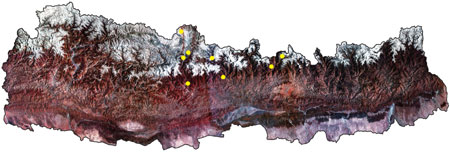|
|
| OVER THE RAINBOW: Two weeks ago this was the view from Ghandruk, just a few hour\'s walk from Pokhara. Monsoon trekking at its most sublime. |
Typically, people think of trekking in the monsoon a pain. There are unpredictable sporadic showers that become torrential in minutes, the trails are slippery, there are landslides, and the leeches can find their way anywhere.
But there are beautiful sights you take in only during the monsoon: huge fields of blossoming wildflowers, wild mushrooms as big as your head, the mountains rising majestically from a garland of clouds.
You just have to know how to do it. Some of the many monsoon trekking routes do get more difficult at this time of the year, so added vigilance is good. And it can be hard to preserve one's equanimity in the mud. It gets into your boots, up your pants, and in your hair if you fall. Soon, you will loathe the mud or love it. You slip, fall, get up, walk, and fall again. The cycle continues.
But the rain brings with it freshness. After a heavy rainfall, everything smells clean and in the hills, away from the stench of the city, this is invigorating and worth all the trouble. And the view. Nothing the beats a monsoon view. After pouring their guts out, the clouds are faint and wispy, and rising above them the mountains look more like the mysterious abode of the gods than ever-beautiful, imposing, and pure. The fields are a patchwork of colours, with flowers of every shape, size, and hue in full bloom. The hills are a lush green, compared to the gold brown of the summer and winter.
The mud and leeches soon become minor annoyances. Even a route travelled many times before becomes fresh and new. The rain is energising, unlike the bitter cold winters, and the suffocating muggy summers.

Ravishing rainy day routes:
Mustang
You could avoid the rain almost entirely by flying into Jomsom and heading through Upper Mustang to Lo Manthang. You might have to wade through some pretty wide streams at this time of year, but keep a sure footing and enjoy the bracing water. The magnificent Kali Gandaki keeps you company for the first two days, past Chele (3030m). Be careful from Chele to Ghemi where the rocky, narrow trail can get slippery after a rare rainfall. The next day you reach Lo Manthang (3760m), the walled capital of the Loba Bista kings that is rich in well-preserved local architecture, monasteries, and some rather curious people.
Muktinath
In the monsoon, the trail from Beni to Jomsom in Nepal's most celebrated rainshadow area is pleasantly bereft of travellers. The well-preserved villages of Marpha and Tukuche, the wide, leech-safe trail that is actually a mule highway and the looming sight of the Dhaulagiri and Annapurna massifs towering 5km over you make the walk up as dramatic as Muktinath's sacred flame. Cross the Thorong La into Manang if you want to-and it's a pleasure in the monsoon to not have to fight the hundreds of trekkers who cross over the pass everyday in peak season-or just fly out of Jomsom.
Nar Phu
The recently-opened areas of Nar and Phu valleys are perfect for the adventurous traveller. In five to seven days you get from the roadhead just past Besisahar to Phu (3,761m) through increasingly rugged and uninhabited terrain. This is no apple pie trail, but the monsoon view of the 6,981m Kanguru is priceless. A one-day trip to Nar and then over the Kang La (5,240m) brings you back to the Annapurna Circuit. If you haven't had enough, you can spend a day in Manang, then up Thorong La (5,416m), and down the other side to Muktinath. And forget about leeches at this altitude.
Gosainkunda
Less than a day's bus ride brings you to Dhunche, and from there it's a couple of days up to the holy lake of Gosainkunda (4,000m). When the clouds give you a break, they reveal the breathtaking Ganesh range. Take a dip in the crystalline, freezing waters, feel cleansed of all sin, and then either continue northeast to the Langtang Valley and down to Kathmandu, or walk through Helambu coming down to Sundarijal in two days.



